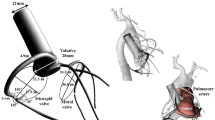Abstract
Simulation of three-dimensional (3D) blood flow in a distal end-to-side anastomosis for two total graft flowrate redistributions was performed. For the same total blood flow, the distal end-to-end anastomosis was analyzed. The aim was to analyze the applicability of two hypotheses for intimal hyperplasia (IH) formation in a distal anastomosis of bypass graft: (i) high WSS combined with high WSS gradient and (ii) low wall shear stress (WSS) combined with high stress oscillations. A newly proposed endothelial stretching index (ESI), related to the first hypothesis, and the Relative retention time (RRT), related to the second hypothesis, were calculated over the graft and artery wall, and compared in the considered cases. High ESI regions within end-to-side distal anastomosis correlate very well with regions that were observed to develop IH in vivo. In such anastomosis, the stagnation point in the velocity field travels significantly along the artery floor within a heart period, resulting with highly oscillatory wall shear stress and its high gradient, and predisposing for the IH formation. In end-to-end anastomosis, the obtained values of these two indices are low, which correlates well with low predisposition for IH formation in this type of anastomosis. In the region close to the suture line the high value of ESI indicates IH formation, offering an additional explanation for IH initiation. When planning surgery, it is better to choose an end-to-end distal anastomosis configuration when possible. One possible solution for reducing IH in the end-to-side distal anastomosis is replacing the part of the native artery subjected to high-oscillatory wall shear stress with a prefabricated prosthetic graft.
Access this chapter
Tax calculation will be finalised at checkout
Purchases are for personal use only
Similar content being viewed by others
References
Abularrage, C.J., Neville, R.F.: Infrainguinal revascularization. In: Surgical Pitfalls. Elsevier Inc., pp. 613–30 (2009). https://doi.org/10.1016/B978-141602951-9.50076-1
Collins, M.J., et al.: Therapeutic strategies to combat neointimal hyperplasia in vascular grafts. Expert Rev. Cardiovasc Ther. 10(5), 635–647 (2012). https://doi.org/10.1586/erc.12.33
O’Brien, T.P., Grace, P., Walsh, M., Burke, P., McGloughlin, T.: Computational investigations of a new prosthetic femoral-popliteal bypass graft design. J. Vasc Surg. 42(6), 1169–1175 (2005). https://doi.org/10.1016/j.jvs.2005.08.016
Keynton, R.S., Evancho, M.M., Sims, R.L., Rodway, N.V., Gobin, A., Rittgers, S.E.: Intimal hyperplasia and wall shear in arterial bypass graft distal anastomoses: an in vivo model study. J. Biomech. Eng. 123(5), 464–473 (2001). https://doi.org/10.1115/1.1389461
Haruguchi, H., Teraoka, S.: Intimal hyperplasia and hemodynamic factors in arterial bypass and arteriovenous grafts: a review. J Artif Organs. 6(4), 227–235 (2003). https://doi.org/10.1007/s10047-003-0232-x
Dolan, J.M., Meng, H., Singh, S., Paluch, R., Kolega, J.: High fluid shear stress and spatial shear stress gradients affect endothelial proliferation, survival, and alignment. Ann. Biomed. Eng. 39(6), 1620–1631 (2011). https://doi.org/10.1007/s10439-011-0267-8
Peiffer, V., Sherwin, S.J., Weinberg, P.D.: Does low and oscillatory wall shear stress correlate spatially with early atherosclerosis? a systematic review. Cardiovasc Res. 99(2), 242–250 (2013). https://doi.org/10.1093/cvr/cvt044
Meng, H., Tutino, V.M., **ang, J., Siddiqui, A.: High WSS or low WSS? complex interactions of hemodynamics with intracranial aneurysm initiation, growth, and rupture: toward a unifying hypothesis. AJNR Am. J. Neuroradiol. 35(7), 1254–1262 (2014). https://doi.org/10.3174/ajnr.A3558
Tuković, Ž., Karač, A., Cardiff, P., Jasak, H., iIvanković, A.: OpenFOAM finite volume solver for fluid-solid interaction. Trans. FAMENA 42(3), 1–31 (2018). https://doi.org/10.21278/TOF.42301
Westerhof, N., Elzinga, G., Sipkema, P.: An artificial arterial system for pum** hearts. J. Appl. Physiol. 31(5), 776–781 (1971). https://doi.org/10.1152/jappl.1971.31.5.776
Ku, D.N., Giddens, D.P., Phillips, D.J., Strandness, D.E., Jr.: Hemodynamics of the normal human carotid bifurcation: in vitro and in vivo studies. Ultrasound Med. Biol. 11(1), 13–26 (1985). https://doi.org/10.1016/0301-5629(85)90003-1
Himburg, H.A., Grzybowski, D.M., Hazel, A.L., LaMack, J.A., Li, X.M., Friedman, M.H.: Spatial comparison between wall shear stress measures and porcine arterial endothelial permeability. Am J. Physiol. Heart Circ. Physiol. 286(5), H1916–H1922 (2004). https://doi.org/10.1152/ajpheart.00897.2003
Donadoni, F., Pichardo-Almarza, C., Homer-Vanniasinkam, S., Dardik, A., Díaz-Zuccarini, V.: Multiscale, patient-specific computational fluid dynamics models predict formation of neointimal hyperplasia in saphenous vein grafts. J. Vasc Surg Cases Innov Tech. 6(2), 292–306 (2020). https://doi.org/10.1016/j.jvscit.2019.09.009
Lemson, M.S., Tordoir, J.H., Daemen, M.J., Kitslaar, P.J.: Intimal hyperplasia in vascular grafts. Eur J. VascEndovasc Surg. 19(4), 336–350 (2000). https://doi.org/10.1053/ejvs.1999.1040
Trubel, W., Schima, H., Czerny, M., Perktold, K., Schimek, M.G., Polterauer, P.: Experimental comparison of four methods of end-to-side anastomosis with expanded polytetrafluoroethylene. Br J Surg. 91(2), 159–167 (2004). https://doi.org/10.1002/bjs.4388
Francis, L., Fischer, P.F., Bassiouny, H.S.: Annual Review of Fluid Mechanics 40(1), 367-93 (2008)
Bassiouny, H.S., White, S., Glagov, S., Choi, E., Giddens, D.P., Zarins, C.K.: Anastomotic intimal hyperplasia: mechanical injury or flow induced. J. Vasc Surg. 15(4), 708–16 (1992); discussion 716–7. https://doi.org/10.1067/mva.1992.33849
Author information
Authors and Affiliations
Corresponding author
Editor information
Editors and Affiliations
Rights and permissions
Copyright information
© 2024 The Author(s), under exclusive license to Springer Nature Switzerland AG
About this paper
Cite this paper
Krizmanić, S., Papeš, D., Pavić, P., Virag, Z. (2024). High Wall Shear Stress and Its Gradient Indicates Intimal Hyperplasia in Vascular Bypass Graft End-to-Side Distal Anastomosis. In: Bonačić Bartolin, P., Magjarević, R., Allen, M., Sutcliffe, M. (eds) Advances in Biomedical and Veterinary Engineering. BioMedVetMech 2022. IFMBE Proceedings, vol 90. Springer, Cham. https://doi.org/10.1007/978-3-031-42243-0_3
Download citation
DOI: https://doi.org/10.1007/978-3-031-42243-0_3
Published:
Publisher Name: Springer, Cham
Print ISBN: 978-3-031-42242-3
Online ISBN: 978-3-031-42243-0
eBook Packages: EngineeringEngineering (R0)




